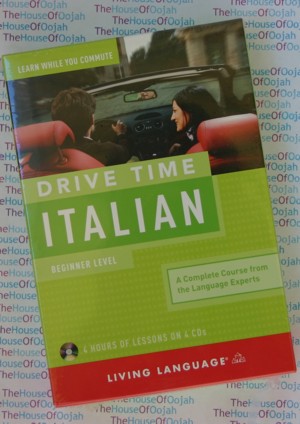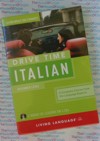Learn ITALIAN while you drive - 4 Audio CDs + Reference Guide - Drive Time

Drive Time ItalianLearn italian while you drive4 Audio CDs - play in your car - portable CD player - or at home - (they are not computer software) Get Other Italian Language Learning click here |
 |
Drive Time Italian - Learn to Speak Italian on 4 Audio CDsBrand New - 4 hours of lessons on 4 CD's Now anyone can learn a foreign language while commuting to work, running errands, or even taking a trip with the family. The new all-audio Drive Time series starts with an ingenious “On-Ramp” CD that eases language learners into Italian with simple, practical expressions and engaging warm-up exercises. Three additional CDs contain 18 lessons that cover all of the essentials—vocabulary, pronunciation, grammar, and basic conversation. About the Italian LanguageItalian is a Romance language spoken as mother-tongue by about 60 million people in Italy, and by a total of around 75 million in the world. In Switzerland, Italian is one of four official languages. It is also the official language of San Marino, as well as the primary language of Vatican City. Standard Italian, adopted by the state after the unification of Italy, is based on Tuscan and is somewhat intermediate between the Italo-Dalmatian languages of the South and the Gallo-Romance Northern Italian languages. Its development was also influenced by the other Italian dialects and by the Germanic language of the post-Roman Barbaric invaders but first and foremost it has been directly and heavily influenced by Latin. The history of the Italian language is long, but the modern standard of the language was largely shaped by relatively recent events. The earliest surviving texts which can definitely be called Italian (or more accurately, vernacular, as opposed to its predecessor Vulgar Latin) are legal formulae from the region of Benevento dating from 960-963. What would come to be thought of as Italian was first formalized in the first years of the 14th century through the works of Dante Alighieri, who mixed southern Italian languages, especially Sicilian, with his native Tuscan in his epic poems known collectively as the Commedia, to which Giovanni Boccaccio later affixed the title Divina. Dante's much-loved works were read throughout Italy and his written dialect became the "canonical standard" that all educated Italians could understand. Dante is still credited with standardizing the Italian language and, thus, the dialect of Tuscany became the basis for what would become the official language of Italy. Italy has always had a distinctive dialect for each city since the cities were, until recently, thought of as city-states. The latter now has considerable variety, however. As Tuscan-derived Italian came to be used throughout the nation, features of local speech were naturally adopted, producing various versions of Regional Italian. In contrast to the Northern Italian language, southern Italian dialects and languages were largely untouched by the Franco-Occitan influences introduced to Italy, mainly by bards from France, during the Middle Ages but, after the Norman conquest of southern Italy, Sicily became the first Italian land to adopt Occitan lyric moods (and words) in poetry. Even in the case of Northern Italian language, however, scholars are careful not to overstate the effects of outsiders on the natural indigenous developments of the languages. The economic might and relative advanced development of Tuscany at the time (Late Middle Ages), gave its dialect weight, though Venetian language remained widespread in medieval Italian commercial life. Also, the increasing political and cultural relevance of Florence during the periods of the rise of Medici's bank, Humanism and the Renaissance made its dialect, or rather a refined version of it, a standard in the arts. The re-discovery of Dante's De vulgari eloquentia and a renewed interest in linguistics in the 16th century sparked a debate which raged throughout Italy concerning which criteria should be chosen to establish a modern Italian standard to be used as much as a literary as a spoken language. Scholars were divided into three factions: the purists, headed by Pietro Bembo who in his Gli Asolani claimed that the language might only be based on the great literary classics (notably, Petrarch, and Boccaccio but not Dante as Bembo believed that the Divine Comedy was not dignified enough as it used elements from not-lyric registers of the language), Niccolò Machiavelli and other Florentines who preferred the version spoken by ordinary people in their own times, and the courtiers like Baldassarre Castiglione and Gian Giorgio Trissino who insisted that each local vernacular must contribute to the new standard. A fourth faction claimed that the best variety of Italian was the one that the papal court adopted. Eventually Bembo's ideas prevailed, the result being the publication of the first Italian dictionary in 1612 and the foundation of the Accademia della Crusca in Florence (1582-3), the official legislative body of the Italian language. Two notable defining moments in the history of the Italian language came between 1500 and 1850. Both events were invasions. The rulers of Spain (themselves members of the Habsburg dynasty) invaded and occupied Italy down to Rome and the Vatican in the mid-16th century (see the aftermath of the Italian Wars). This occupation left a lasting influence upon the formerly irregular Italian grammar, simplifying it to conform more with the dominant Spanish language. The second was the conquest and occupation of Italy by Napoleon in the early 19th century (who was himself of Italian-Corsican descent). This conquest propelled the unification of Italy and pushed the Italian language to a lingua franca, further reducing regional languages in order to compensate for the increased united nature of the people. |
Drive Time Italian - Learn to Speak Italian on 4 Audio CDs |
| Retail: | $44.99 |
| On Sale: | $39.95 |
| You Save: | 12% |
| Stock Info: | Out Of Stock |
| Receive In Stock Notification |

 0 Items (Empty)
0 Items (Empty)

